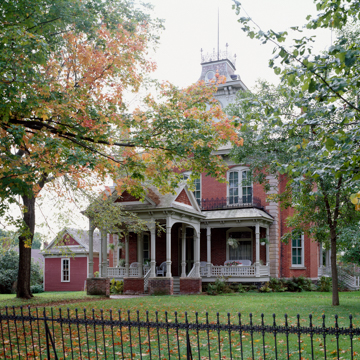Set off from neighboring houses by its broad lawn and ornate iron fence, this showy house flaunts the prosperity of the late-nineteenth-century lumber trade in Chippewa Falls. From 1887 until his death in 1914, lumber company executive Edward Rutledge lived here. Rutledge first worked as a “timber cruiser” for lumber magnate Frederick Weyerhaeuser, assessing the value of prospective timberland purchases. When Weyerhaeuser bought the Chippewa Lumber and Boom Company in 1881, he made Rutledge its vice president. At that time the firm’s sawmill was one of the world’s largest, and Rutledge became a millionaire.
The rear wing of the Rutledge House was once the whole house. Built around 1869, it was home to E. D. Rand, part owner of another local lumber firm that Weyerhaeuser eventually absorbed into his system of interlocking syndicates. It took on its present look in 1887, when Rutledge moved in. To convey his prosperity he more than doubled the dwelling’s size and dressed it with Italianate details. The large front section Rutledge added bears the same Italianate traits as the original section to the rear: tall narrow windows (some with brick hood moldings), quoins edging the red-brick walls, a dentiled cornice with paired brackets, and a low-pitched hipped roof. New features included porches, a polygonal bay, and an enormous rooftop belvedere, whose mansard roof has circular dormers and culminates in a lacy iron cresting. Rutledge, like many newly minted millionaires, was more interested in flaunting wealth than adhering to a particular style. Thus he also added such Queen Anne elements as second-story windows with frilly iron balconets, stained glass transoms over the window in the front porch, and a cross-gabled porte-cochere with semi-elliptical openings.
The Chippewa County Historical Society maintains the house as a museum.


